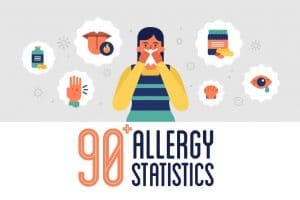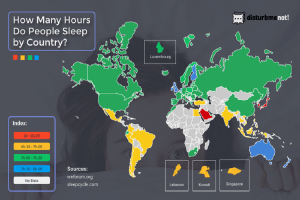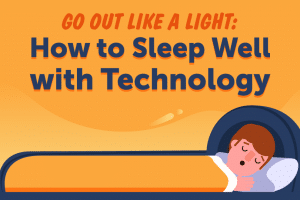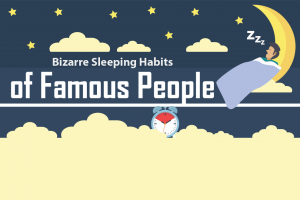80 Eye-Opening Stats & Facts About Sleep (Infographic)
written by / January 24, 2021
Along with proper nutrition and regular exercise, sleep plays a major role in our health. With this in mind, we shouldn’t neglect this aspect of our lives the way we do. That’s why we compiled this list of interesting statistics about sleep, hoping they’ll help you recognize the importance of sleep and realize that you shouldn’t take it for granted.
Eye-Opening Sleep Statistics and Facts
- You spend about a third of your life sleeping.
- 65% of Americans believe that adequate sleep boosts their effectiveness.
- 45% of Americans report that inadequate sleep affects their daily activities.
- 70% of college students don’t get enough sleep, according to college student sleep statistics.
- Between 50 and 70 million people in the US suffer from a chronic sleep disorder.
- In 2017, drowsy driving was responsible for 795 fatalities.
- 7.6% of people have experienced sleep paralysis at least once in their lifetime.
- 10% of US adults have chronic insomnia.
- Approximately 4% of Americans used prescription sleeping pills in a one-month period.
- 24.4% of surveyed parents often would share their bed with their infants.
We’ll elaborate on these and many more stats below. But first, check out the infographic.
General Sleep Stats
In this section, we’ll be looking at the general statistics and facts that you should know about sleep.
1. You spend about a third of your life sleeping.
(American Sleep Apnea Association)
This is simple math if you assume that every person sleeps 8 hours a day on average.
2. Most healthy adults need at least 7 hours of sleep a night to feel rested.
(SleepFoundation.org)
Most people can’t perform at their peak without at least seven hours of sleep. However, one of the devastating facts about sleep is that more and more people are not getting the recommended minimum. Check out this infographic to find out how much sleep some of the famous people usually get.
3. 65% of Americans believe that adequate sleep boosts their effectiveness.
(SleepFoundation.org)
According to statistics on sleep and performance, people with higher incomes and college degrees often claim that they are more effective if they get adequate sleep.
4. 45% of Americans report that inadequate sleep affects their daily activities.
(SleepFoundation.org)
It’s no wonder that people with sleep problems can’t perform at their peak since lack of sleep impairs their ability to concentrate, leaving them feeling tired and unfocused.
5. Sleep is a top priority to only 1 in 10 Americans.
(SleepFoundation.org)
According to American sleep statistics, most people place physical fitness and nutrition in first place when prioritizing their personal activities and health needs.
6. Our sleep consists of 25% REM and 75% NREM sleep.
(SleepFoundation.org)
Our brains are most active during REM (rapid eye movement) sleep, and this is when we dream the most vividly.
7. 56% of vigorous exercisers report having a good night’s sleep almost every night.
(SleepFoundation.org)
Conversely, according to sleeping statistics, 47% of non-exercisers claim they rarely have a good night’s sleep. Therefore, we can conclude that exercising greatly improves our sleep.
8. Our body temperature decreases by 1°–2° during sleep.
(WebMD)
A lower body temperature promotes sleep and helps us stay asleep. It increases a few hours before we wake up, preparing our body for a new day.
Sleep Disorders and the Statistics About Them
Many people around the world suffer from a sleep disorder. Here, we’ll be looking at sleep disorder statistics.
9. Between 50 and 70 million people in the US suffer from a chronic sleep disorder.
(NCBI)
Considering the serious consequences sleep disorders can cause, this is something we should worry about. To list just some of them: they can lead to accidents and injuries, impair quality of life, reduce productivity, and increase healthcare costs. For example, according to sleep apnea statistics, people with this sleep disorder are more likely to have a car crash than those who don’t suffer from obstructive sleep apnea.
10. There are about 90 different sleep disorders.
(NCBI)
Insomnia, disrupted breathing, and narcolepsy are among the most common ones. The most prevalent sleep disorder symptoms include problems with falling or remaining asleep, abnormal behaviors during sleep, and excessive drowsiness.
11. More than 25 million Americans suffer from obstructive sleep apnea.
(AASM)
Men are more likely to have this chronic disease than women. Sleep apnea may lead to some serious medical conditions, including Type 2 diabetes, high blood pressure, and stroke.
12. 7.6% of people have experienced sleep paralysis at least once in their lifetime.
(NCBI)
Therefore, sleep paralysis statistics show that this is quite a common sleep disorder. In addition, it’s more prevalent among students and psychiatric patients, 28.3% and 31.9%, respectively.
13. 10% of US adults have chronic insomnia.
(American Sleep Association)
This makes insomnia the most prevalent sleep disorder. It’s followed by sleep apnea and narcolepsy.
14. Approximately 40% of men snore.
(Sleep Education)
There are fewer habitual snorers among women—about 24%.
Sleep Deprivation Statistics
Sleep deprivation can cause all kinds of problems. In this section, we’ll be taking a closer look at sleep deprivation.
15. It’s estimated that 68% of Americans, or 164 million, have sleep problems at least once a week.
(Consumer Reports)
This fact is based on a Consumer Reports survey that included 4,023 participants. According to this article, the major reason for having less sleep is that Americans work longer hours: 44 hours a week on average.
16. Approximately 35% of US adults get less than the recommended 7 hours of sleep per night.
(CDC)
Sleep-deprived people, based on statistics, have a higher risk of obesity. Besides the correlation between obesity and sleep, an inadequate night’s rest can also lead to diabetes, high blood pressure, and coronary heart disease, among other things. That’s why you should develop healthy sleep habits.
17. 97% of surveyed teenagers reported sleeping less than what’s recommended.
(Scientific American)
Experts recommend that teens should sleep 8–10 hours each night.
18. As for college students, sleep statistics show that about 8 in 10 students believe that a lack of sleep affects their academic performance.
(NCBI)
Some of the reasons college students don’t sleep enough include binge drinking, caffeine and energy drink consumption, and the use of technology before going to bed.
19. 70% of college students don’t get enough sleep.
(NCBI)
According to some confirmed lack of sleep statistics, sleep-deprived college students are more likely to have lower grade point averages. In addition, inadequate sleep and daytime sleepiness negatively affect their learning capabilities and mood.
20. About 4% of surveyed adults fell asleep while driving in a single month.
(CDC)
Since drowsy driving can be extremely dangerous, it’s of immense importance to get enough sleep before taking the wheel. If you have a sleep disorder, you should get adequate treatment and not take any medications before driving that make you sleepy.
21. In 2017, drowsy driving was responsible for 795 fatalities.
(National Highway Traffic Safety Administration)
Based on the NHTSA sleep statistics, drowsy drivers participated in 90,000 car crashes in 2015. Therefore, you should follow some useful tips on staying alert while driving, such as getting a good night’s sleep before starting a trip and avoiding drinking alcohol prior to driving.
Sleep Market Stats
What are the direct and indirect costs related to sleep and sleep disorders?
22. Approximately 4% of Americans used prescription sleeping pills in a one-month period.
(CDC)
According to a CDC study, more women use prescription sleep medications than men. Also, the use of sleeping pills increases with age.
23. The US “sleep market” was valued at $28.6 billion in 2017.
(MarketResearch.com)
Considering how many people have sleep disorders, it’s no surprise there’s a great demand for medications and other sleep-related products that alleviate these problems. It’s expected that this market will have an average annual growth rate of 4.7% over the next few years.
24. The CPAP device market is worth $4.3 billion.
(MarketResearch.com)
Since obstructive sleep apnea is becoming more and more prevalent, this segment of the sleep market is also growing every year. However, its huge potential has yet to be tapped in the US.
25. It’s estimated that the global mattress market was worth $31 billion in 2017.
(Prescient & Strategic Intelligence)
Consumers are more and more interested in healthy sleep habits and eco-friendly materials, which creates lucrative opportunities for mattress manufacturers.
Technology and Sleep
In this section, we’ll be exploring the relationship between technology and sleep.
26. 8% of Americans use an app to track their sleep.
(Statista)
According to a survey conducted in 2017, 31% of US adults don’t want to use an app to track their sleep behavior.
27. 62% of adolescents who participated in the NCBI study took their phones to bed.
(NCBI, SleepFoundation.org)
A considerable number of them also used their phones for texting after “lights out.” This explains why so many adolescents have sleep problems, since the use of technology at bedtime has a negative effect on the quality and quantity of sleep. In fact, one of the most unhealthy sleeping habits is using a smartphone before sleep. Based on teenage sleep deprivation statistics, most teenagers sleep less than the recommended eight hours a night, and one of the common tips on how to improve both sleep quantity and quality is to avoid using electronic devices about an hour before going to bed.
28. 89% of surveyed parents have at least one electronic device in their bedroom.
(National Sleep Foundation)
According to this poll from a few years ago, most of them had a TV (62%), which was followed by a tablet or smartphone (45%).
Sleep Facts About Bedroom Habits
How do your bedroom habits affect your sleep? Here, we’ll be looking at sleep and behavior in the bedroom.
29. 43% of Americans sleep on two pillows.
(National Sleep Foundation)
It’s interesting that only 1% of respondents don’t sleep on any pillows.
30. 62% of Americans change their sheets at least once a week.
(National Sleep Foundation)
Based on the sleep statistics compiled on a worldwide level, the Japanese change sheets the most rarely compared to other respondents. 28% of them do it less often than every three weeks.
31. 40% of US adults said that a quiet bedroom is important to them.
(Statista)
Adults aged 18–29 needed a quiet bedroom more often than the participants aged 30 or older.
32. Only 7% of Americans regularly wear socks in bed.
(Statista)
In addition, 16% of the respondents said that they sometimes wear socks in bed.
Worldwide Sleep
In this section, we’ll be discussing sleep throughout the world.
33. On average, the Japanese sleep 7 hours and 24 minutes each night.
(BBC)
According to recent sleep studies, the Japanese are among the nations that sleep the least. This piece of information comes from a study that analyzed data collected from an app that records such things.
34. People in the Netherlands sleep an average of 8 hours and 12 minutes.
(BBC)
According to the same study, the Dutch sleep longer than most other nations.
35. In China, around 20% of people consume prescription sleep aids.
(Loughborough University)
According to the Worldwide Sleep Census conducted in five countries, China has the highest percentage of prescription sleeping pill use. According to the same insomnia statistics, people from South Korea use prescription sleep medications the least—only 1 in 30 people.
36. About 2% of Brits are satisfied with their sleep quality, waking up well-rested every morning.
(Loughborough University)
It’s shocking that 26% of Brits never feel refreshed and well-rested in the morning, and about 50% of them only occasionally feel refreshed when they wake up, according to sleep statistics from the UK. It’s interesting that the results varied greatly across the country: 85% of people from Sheffield don’t feel well-rested in the morning, while 31% of people from Bristol wake up refreshed.
Fun Facts About Sleep
Here, we’ll be looking at all the fun facts you should know about sleep.
37. People, on average, have 3–5 dreams each night.
(American Sleep Association)
Some people have up to seven dreams a night. Usually, we don’t remember most of our dreams because we can only recall them if we wake up during the REM phase of sleep.
38. 1 in 4 Americans will typically go to bed at the same time as their partner.
(Statista)
Additionally, when surveyed, 1 in 5 US adults indicated that they do this from time to time.
39. 24.4% of surveyed parents often would share their bed with their infants.
(Statista)
Based on recent sleep stats, this is a growing trend in the US even though it’s against the medical advice given by the American Academy of Pediatrics.
Let’s Sum Up
Juggling so many things at the same time—private life, career, family responsibilities—we tend to overlook the importance of sleep. More often than not, we sacrifice an hour or two of our precious night’s rest so we can fit all our daytime activities in.
However, inadequate sleep can have a number of serious negative effects on our health, mind, productivity, and focus. We hope that these sleep statistics for 2021 compiled from several reliable sources will help you understand that having enough ZZZs is vital to your well-being.





